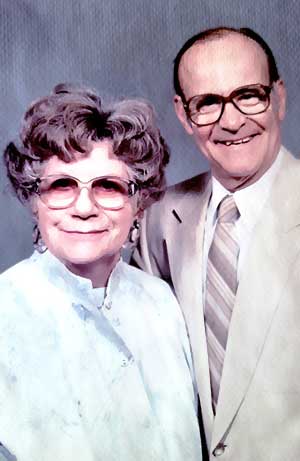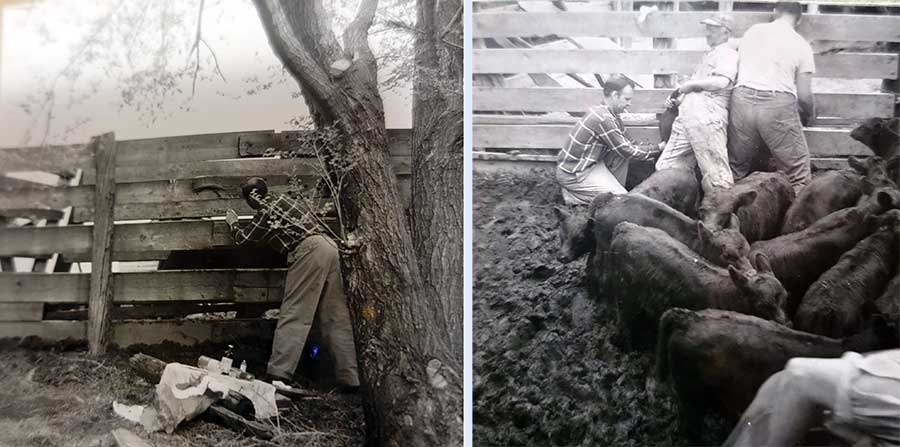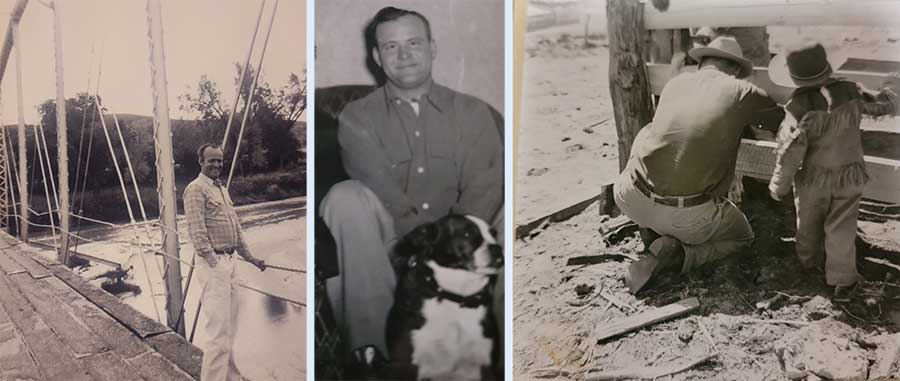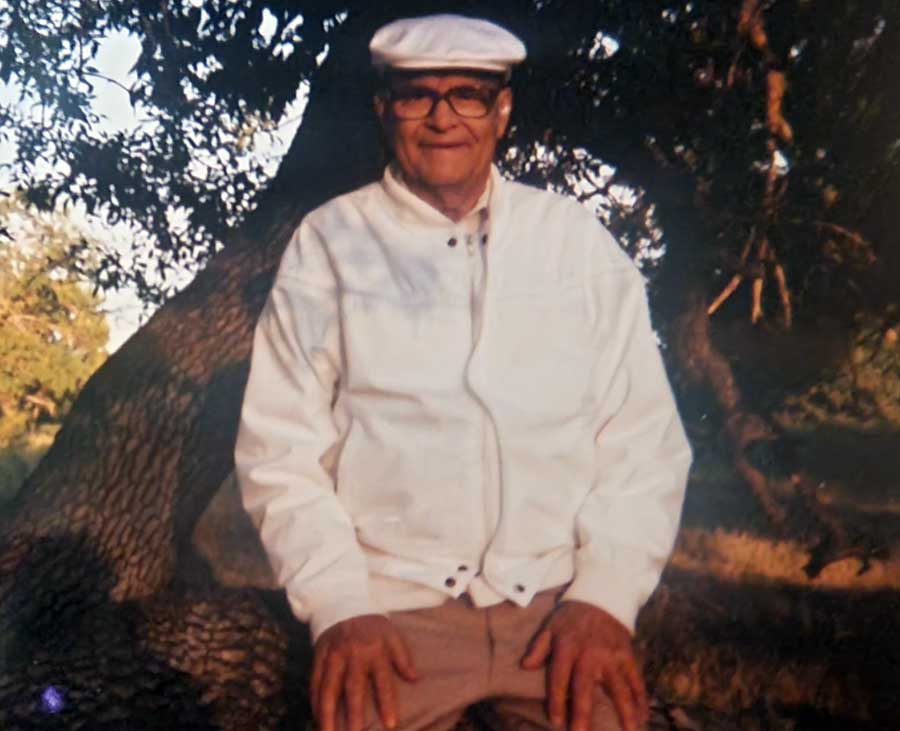Dr. Veryl Walstrom, DVM 1946
 “Just follow us.”
“Just follow us.”
After the death of Dr. John Bruce, young Doc Walstrom and his wife Jean arrived in Verdigre driving a Model A Ford purchased from Dr. Mueller, Ogallala, Nebraska, veterinarian, in May of 1946.
The Walstroms made a brief visit there, then went on down to Weeping Water, Nebraska, and were in the process of setting up office when a delegation sent by Jim Chalupnik arrived from Verdigre, Nebraska, including Gordon McElhose, Adolph Kotrous, Joe Jacot Sr., Tony Scheinost, and William Eichenberger. They walked in, loaded up Doc’s medicine and said “Follow us.”
The Model A made it back to Verdigre, Nebraska, where Doc and Jean have been ever since. Doc practiced there for 51 years.
After beginning practice in a wood building located north and adjacent to what became Jedlicka’s Gambles Store, Walstrom built their office in 1948 on a vacant lot next to what was then the Bartek Harness Shop and is now occupied by an addition to the bank.
Dr. Veryl A. Walstrom is a native of Iowa. He was born June 1, 1921, on a farm near Royal, Iowa and died in Verdigre, Nebraska, March 10, 1997. He graduated from Spencer High School and received a degree in Agronomy from Iowa State University, Ames, Iowa. He opted for Kansas State University School of Veterinary Medicine because of its trimester system and earlier starting date. After serving in the U.S. Army Chemical Warfare Service, he received his DVM degree in 1946. Working briefly as a field veterinarian with the Nebraska BAI, he established practice in Verdigre, Nebraska, in 1946.

Doc Walstrom served On the Knox County Agricultural Society’s Fair Board of Directors from 1950 until 1993, spending the last 24 years of his tenure as President. He missed only one meeting during his years on the board.
Some of his other leadership roles included Democratic State Central Committee 26 years; Acting Chairman and Vice Chairman Knox County Democratic Party; represented Nebraska at five National Democratic National Conventions and was Knox County’s official delegate to every State Democratic Party Convention since 1950, establishing a state record.
Dr. Veryl Walstrom also served on the Executive Committee for the Nebraska Livestock Market Inspectors 20 years and served as a Nebraska Brand Committee Member for 44 years. He served as veterinarian of the Verdigre Livestock Market since it opened.
He was a charter member of the Nebraska Educational Service Unit 1, 18 years; Degree Mason of Yankton SD Consistory; member and past President of Verdigre Improvement Club; United Methodist Church Board member and trustee, Chair of the Pastor-Parish Committee, and Auditor for a number of years.
Dr. Walstrom also was a member and past adjutant of American Legion Post 259.
He was a 50-year member of the American Veterinary Medical Association and was awarded a lifetime membership in 1987.
In 1965, Dr. Veryl Walstrom was the only Nebraskan to participate in the Veterinary Goodwill People to People tour to the Soviet Union, Hungary, and other locations in Europe including colleges of Veterinary Medicine. Most interesting was the meeting in Moscow with the official in charge of USSR veterinary medicine, second in command of the Department of Agriculture there. His talk briefed the group on animal diseases there, with emphasis on great accomplishments. It is now interesting to recall that they were fighting TGE long before it ever was confirmed in our Midwest.
Dr. Walstrom published a book in 1995 called “My Search for the Burial Sites of Sioux Nation Chiefs.” This was inspired when the realization came that he knew where many of these burial sites were as the result of his veterinary work, drives, and friendships made throughout the Sioux country.
Doc had the most unique hobby of any Nebraska veterinarian, turtle racing (see story here). He has been a consistent winner with championships in four states. Doc also used this time to teach others about turtles and advocate for the protection of turtles and their environments.
Doc and his wife Jean, while attending KSU worked in the campus cafeteria and also took care of pets on campus including General Dwight D. Eisenhower’s Scottish terrier named Telek who periodically stayed at KSU. Telek sometimes arrived late in the evening and enjoyed company and care at KSU during World War II years when the General had to be stationed overseas. General Dwight D. Eisenhower’s younger brother Milton S. Eisenhower was President of KSU while Doc and Jean were students there.
Doc’s wife Jean was born at West Bend, Iowa, and grew up in Graettinger, Iowa, where she graduated with honors in 1942. She worked in an office at a silo factory and taught at a rural school following graduation.
By carrying a double schedule, she graduated from KSU with a B.S. degree in education in January of 1946, and was recognized as a member of Phi Alpha Mu, educational honorary.

In addition to assisting her husband in his practice, raising two children and helping with various community endeavors, Jean has worked with Verdigre, Nebraska, youth for over 40 years, first as MYF sponsor, later as a middle and secondary school art teacher.
In 1949 she helped establish the Federated Women’s Club of which she was President and later District President. In 1952 she was appointed member of the first official library board in Verdigre. She also helped organize the first Extension Club there, later serving as President and County Officer.
Jean was active in the United Methodist Church and served as counselor for the National Convocation, Purdue University, Youth School of Mission, Nebraska Wesleyan University, district WSCS officer, delegate to Jurisdictional Leadership Conference at Mt. Sequoyah Arkansas, local and district lay leader and speaker, administrative board and trustee.
For several years she was speaker or reader at Memorial Day Services, some church services, conventions, and local funeral services. A lot of effort went into writing appropriate material for the occasions.
In 1979 the Senior Class of Verdigre High School invited her to be their guest graduation speaker. Her theme was a tribute to taxpayers, parents, and board members who had maintained the school through hardships of depression, drought, food, and war. There was dead silence as she closed this presentation and she sat down thinking it had not been well received. Then the audience in the auditorium erupted. They all stood up, yelled their support, and gave her a long standing ovation.
Both of Doc & Jean’s children, Cleve and Julie, enjoyed going on calls with Doc and began to do so at a very early age. Doc would put Cleve in a manger for safekeeping and as long as the cow bawled, Cleve bawled. When the cow quit, Cleve quit. On Christmas he used his piggy bank savings to buy a gas can and snow shovel for his dad. He did not like to run out of gas every now and then and had found that his own snow shovel did not get him very far when they were stuck in deep snow.
Julie as a teen trained and performed trick horses throughout Northeast Nebraska. The horses were owned and managed by A.F. Repenning of Bloomfield, Nebraska. Julie and two other girls worked with the horses without halters, bridles, and saddles. The people’s favorite presentation was the horse Queen standing on a pedestal only 15 inches in diameter.
Cleve Walstrom graduated from Verdigre High School in 1970. His education continued at Kearney State College, Xi Phi Honorary; San Francisco College of Mortuary Science, National Association of Colleges of Mortuary Science, Mu Sigma Alpha Award (4.0 honors) . He is a retired mortician who originally served the Marysville and Hanover, Kansas, areas. He was formerly chairman and director of the city recreational program and was on the board of the Blue Valley National Bank. Cleve is a US Track and Field Official often officiating University of Kansas, Nebraska and Kansas State meets and he maintains professional associations in Kansas, Nebraska and Iowa; is a counselor, youth leader, church official, public speaker, champion turtle racer, and in Midwest track.
Cleve married Rosemary Mlinar in 1976. She also graduated from Verdigre High School in 1970 and from UNL with an M.A. in 1977. She is a speech pathologist. Their children are Veryl Woody, born in 1980, and Wally Chase, born in 1983. Woody serves a wide area as a mortician based out of Marysville, Kansas. Wally graduated from Kansas State University with a dual Bachelor’s degree in Kinesiology and Human Nutrition. He earned his medical degree from the Kansas City University of Medicine and BioSciences. As a graduating K-State student athlete, Wally was awarded the Dr. Prentice Gautt post graduate scholarship in 2007. [Editor's note: Wally was very proud of this, as it is awarded to one male and female athlete from each Big 12 school. He applied it for medical school.] Wally works as a sports medicine physician at Fort Hays State University in Hays, Kansas.
Julie Walstrom graduated from Verdigre High School in 1974. She earned her Bachelor of Science degree at Nebraska Wesleyan University in 1978 and her Master of Arts degree from the University of Nebraska, Lincoln. She was an honored member of Kappa Delta Pi, educational honorary; Who’s Who in American Politics; Outstanding Young Woman of America. She earned her PHD in 1997 in the areas of Training and Development/Community and Human Resources. Julie is an Instructional Designer, Integrative Arts Educator, musician, writer, researcher, photographer, environmentalist, and raises miniature donkeys.
Julie was appointed by the Governor of Nebraska to serve as a Judicial Nominating Commissioner. She was appointed by another Governor to serve as Chair of the Education, Counseling, and Employment Committee on the Commission for the Status of Women. Julie was elected National Party Delegate in 1980 and National Party Official Alternate Delegate in 1984. She served on the Democratic State Central Committee and as Knox County Chair.
Julie is married to Michael Mattison, mechanical engineer. They have a daughter Dr. Wyconda Walstrom, DVM, CCRT, CVWHM who graduated from the Kansas State School of Veterinary Medicine in 2020. She has a Bachelor of Science degree in Animal Science from the University of Nebraska, Lincoln. She currently practices in the Lawrence and Kansas City, Kansas, areas.
Dr. Veryl Walstrom described some of his interesting early experiences as a veterinarian in Nebraska to Dr. Leo Lemonds, DVM for inclusion in his 1982 book called “A Century of Veterinary Medicine in Nebraska. What follows are versions of some of these excerpts.
A most dramatic happening was his first summer in practice. The new veterinarian was called to investigate acute anthrax outbreaks. Penicillin had just come into use and old-timers watched in utter disbelief as cattle sweat blood and recovered when they were about to die. News of the miracle and these first known survivors swept the country and helped convince the young horse doctor he had chosen an exciting profession and location.

At a research excursion to Grant Farm, St. Louis, Anheuser-Busch zoological Reserve, he participated in Dr. Palmer’s early experiments with a tranquilizer gun. Walstrom obtained one of the guns for his own use. It was the first and only tranquilizer gun in the area. He was called upon to use it to tranquillize all of the deer at the Niobrara State Park. It became a bit of a spooky experience when uninformed drivers going by reported a gunman gone berserk, dead deer all over the place, etc., and he had a knife too! By the time the patrol cars had arrived, however, Walstrom had the animals castrated and coming back to life.
When a buffalo corralled near the Missouri River broke loose, tore through fences and wounded cattle across a miles, Walstrom was called to bring his tranquilizer gun and head the “buffalo hunt.” In the process he made a discovery: several cc of nicotine sulfate will not hurt a deer but one drop will kill a buffalo. The “heart failure” victim was buried with much ado and statewide publicity as photographers from Omaha and Associated Press had joined this buffalo hunt. Dr. Palmer later developed succinol hydrochloride, a safe tranquilizer for use in the gun.
Another early experience involved flying rescue missions in a helicopter provided by the National Guard which was called to help alleviate the desperate situation caused by the blizzard of 48-49. The guard headquartered in Walstrom’s newly-built office where he helped direct operations and went with them as a guide because of his wide knowledge of the terrain and needs of the people (“I patched chains with my pig catheters all over this country”). Both animals and owners were running out of food and there were many medical emergencies. Special snow machines were used and whether they came by land or air, rescuers were met by farmers and ranchers who had tears of relief and gratitude in their eyes.
Isolated and in despair, those involved still recall this moment: “I was to my wits’ end when I saw that helicopter land in my yard. A helicopter?!! I thought I must be dreaming or losing my sense, but thank God! It was an answer to a lot of prayers. I must be hallucinating. How did they know how to find us? Well the first one out of the helicopter was Bugs. Then I knew!”
Bugs, a Boston terrier, was Doc’s constant canine companion and became a favorite topic of conversation throughout the area. Doc’s father-in-law had sent Bugs out from Iowa by train as a touch of home to keep Doc’s wife company. Bugs didn’t adapt to being an office dog but happily took up residence in the car where it was assured of getting out into the country as accustomed. When or wherever the car went, Bugs went, sitting on top a box of medicine so she could see out. Once when Doc turned a corner on two wheels the dog slid right out the window. She was discovered continuing her way to the client’s place on foot.
One morning Doc hopelessly was stuck in the middle of the road and went for help cross country on foot. Bugs guarded the car diligently so that no-one could get to town. Doc’s car could not be moved. A long line of cars and farm vehicles grew. This became a game. Each new person arriving laughed at the others and said, “Why, Bugs is my friend. I’ll show you guys I can get in that car. That dog is not vicious!” The car could not be moved until Doc got back. This is remembered as the day Bugs kept west Knox County out of town.
Doc missed the helicopter. He had thought it had been a way to beat the bad roads. He decided to take up flying himself with an airplane. He had a lot of miles to cover and a plane could help. On a trip to vaccinate cattle he landed the plane behind a hill so as not to scare the group of cattle on the other side of the hill. The cattle that needed to be vaccinated were. When he returned to his plane, however, it was discovered that another group of cattle had chewed the wings off the plane. They had been attracted to the glues used on the construction of the wings.
Doc continued his practice on land without using wings. When Pontiac Grand Prixs were invented he purchased one usually yearly, used a V8 engine in it, no air conditioning, put close to 300,000 miles on it, then repeated that process for the rest of his life. These vehicles did not sink down into the gumbo of country back roads as his old Army jeep sometimes did. He arrived always on time right on the button. Every one of his veterinary vehicles was white. His customers always knew when it was him that was coming.